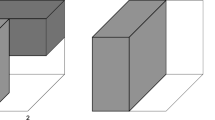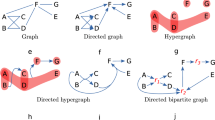Abstract
This paper studies the self-similar fractals with overlaps from an algorithmic point of view. A decidable problem is a question such that there is an algorithm to answer “yes” or “no” to the question for every possible input. For a classical class of self-similar sets {E b.d } b,d where E b.d = ∪ n i=1 (E b,d /d + b i ) with b = (b 1,…, b n ) ∈ ℚ n and d ∈ ℕ ∩ [n,∞), we prove that the following problems on the class are decidable: To test if the Hausdorff dimension of a given self-similar set is equal to its similarity dimension, and to test if a given self-similar set satisfies the open set condition (or the strong separation condition). In fact, based on graph algorithm, there are polynomial time algorithms for the above decidable problem.
Similar content being viewed by others
References
Bandt C, Graf S. Self-similar sets, VII: A characterization of self-similar fractals with positive Hausdorff measure. Proc Amer Math Soc, 1992, 114: 995–1001
Cormen T H, Leiserson C E, Rivest R L, et al. Introduction to Algorithms, 3rd ed. Cambridge: MIT Press, 2009
Dijkstra E W. A note on two problems in connexion with graphs. Numer Math, 1959, 1: 269–271
Dube S. Undecidable problems in fractal geometry. Complex Syst, 1993, 7: 423–444
Dube S. Fractal geometry, Turing machines and divide-and-conquer recurrences. RAIRO Inform Théor Appl, 1994, 28: 405–423
Falconer K J. The Hausdorff dimension of self-affine fractals. Math Proc Cambridge Philos Soc, 1988, 103: 339–350
Falconer K J. Fractal Geometry. Mathematical Foundations and Applications. Chichester: John Wiley & Sons, 1990
Hutchinson J E. Fractals and self similarity. Indiana Univ Math J, 1981, 30: 713–747
Hochman M. On self-similar sets with overlaps and inverse theorems for entropy. ArXiv:1212.1873v5, 2013
Kenyon R. Projecting the one-dimensional Sierpinski gasket. Israel J Math, 1997, 97: 221–238
Kruskal J B. On the shortest spanning subtree of a graph and the traveling salesman problem. Proc Amer Math Soc, 1956, 7: 48–50
Lau K S, Ngai S M. Multifractal measures and a weak separation condition. Adv Math, 1999, 141: 45–96
Lau K S, Ngai S M, Rao H. Iterated function systems with overlaps and self-similar measures. J London Math Soc, 2001, 63: 99–116
Mattila P. Geometry of Sets and Measures in Euclidean Spaces. Cambridge: Cambridge University Press, 1995
Ngai S M, Wang Y. Hausdorff dimension of self-similar sets with overlaps. J London Math Soc, 2001, 63: 655–672
Rao H, Wen Z Y. A class of self-similar fractals with overlap structure. Adv Appl Math, 1998, 20: 50–72
Schief A. Separation properties for self-similar sets. Proc Amer Math Soc, 1994, 122: 111–115
Sipser M. Introduction to the Theory of Computation. Boston: Thomson Course Technology, 2005
Solomyak B. On the random series Σ±λ n (an Erd“os problem). Ann of Math, 1995, 142: 611–625
Wen Z Y. Mathematical Foundations of Fractal Geometry. Shanghai: Shanghai Scientific and Technological Education Publishing House, 2000
Xi L F, Xiong X. Rigidity theorem in fractal geometry. AriXiv:1308.3143, 2013
Zerner M. Weak separation properties for self-similar sets. Proc Amer Math Soc, 1996, 124: 3529–3539
Author information
Authors and Affiliations
Corresponding author
Rights and permissions
About this article
Cite this article
Wang, Q., Xi, L. & Zhang, K. Self-similar fractals: An algorithmic point of view. Sci. China Math. 57, 755–766 (2014). https://doi.org/10.1007/s11425-013-4767-x
Received:
Accepted:
Published:
Issue Date:
DOI: https://doi.org/10.1007/s11425-013-4767-x




